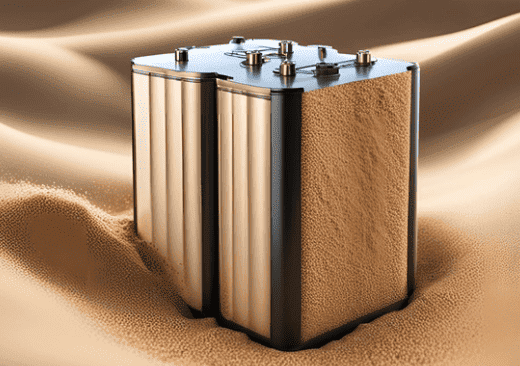
Overview:
In the quest for sustainable and efficient energy storage solutions, sand batteries have emerged as a groundbreaking technology with the potential to reshape the energy landscape. Harnessing the inherent properties of sand, these innovative systems offer a cost-effective and environmentally friendly alternative to conventional energy storage methods. Unlike traditional batteries that rely on rare or expensive materials, sand batteries utilize the abundant and inexpensive nature of sand to store thermal energy, making them a compelling option for addressing the growing demand for reliable and scalable energy storage.
As renewable energy sources like solar and wind become increasingly integral to our power grids, the need for effective energy storage solutions to manage fluctuations and ensure stability has never been more critical. To understand what is a sand battery, we need to examine its unique capability to convert and store electrical energy as thermal energy in sand, which can later be converted back into electricity or used directly for heating purposes. This article explores the key components, advantages, and potential applications of sand batteries, as well as the challenges and future prospects of this emerging technology.
Contents:
- What is a Sand Battery
- Key Components of a Sand Battery
- How a Sand Battery Works
- Potential Application Areas of Sand batteries
- Key Advantages of Sand Batteries
- Potential Challenges and Risks Associated with Sand Batteries
- Futuristic Technological Landscape of Sand Batteries
- Summing Up
So, what is a Sand Battery:
A sand battery is a type of energy storage system that uses sand as a key component. The concept relies on the fact that sand can be used in various ways to store and release energy, often involving the conversion of electrical energy into thermal energy and vice versa.
Key Components of a Sand Battery:
Sand: The primary material used for storing thermal energy. It is chosen for its high heat capacity and abundance.
Heating Mechanism: An electrical or thermal system used to heat the sand. This can involve electric heaters or other methods to efficiently transfer energy to the sand.
Insulated Storage Container: A well-insulated container or chamber where the heated sand is kept. Insulation is crucial to minimize heat loss and maintain the temperature of the sand over time.
Heat Transfer System: A system to transfer heat from the sand to a working fluid or to generate steam when energy is needed. This often includes heat exchangers or thermal conduits.
Energy Conversion System: This can include turbines or generators that convert the thermal energy from the sand into electrical energy, or other mechanisms depending on the specific application.
Control and Monitoring System: Electronics and sensors to monitor the temperature of the sand, control the heating process, and manage the overall operation of the sand battery.
How a Sand Battery Works:
A. Energy Input (Charging Phase):
Heating: Electrical energy is used to heat sand. This is typically done using electric heaters or other heat sources. The sand is chosen for its ability to absorb and retain heat due to its high heat capacity.
Energy Storage: The heated sand is then stored in an insulated container. The insulation helps keep the sand at a high temperature for an extended period, minimizing heat loss.
B. Energy Storage:
Thermal Retention: The insulated container ensures that the stored heat remains in the sand until it is needed. The sand’s thermal energy is retained effectively due to the insulation and the sand’s properties.
C. Energy Output (Discharging Phase):
Heat Transfer: When energy is needed, the stored heat is transferred from the sand to a working fluid or directly used in a thermal system. Heat exchangers or thermal conduits facilitate this transfer.
Energy Conversion: The transferred heat can be used to generate steam, which drives turbines to produce electricity, or it can be used in other thermal applications as needed.
D. Energy Utilization:
Electricity Generation: If the system is set up to generate electricity, the steam produced from the heat is used to drive a generator or turbine.
Direct Use: In some cases, the heat can be used directly for heating purposes, industrial processes, or other thermal applications.
Potential Application Areas of Sand batteries:
1. Renewable Energy Storage:
Grid Balancing: Sand batteries can store excess energy generated from renewable sources like solar or wind when production exceeds demand. The stored energy can then be released during periods of low production to balance the grid.
2. Industrial Heat Storage:
Process Heating: Industries that require high-temperature processes (such as metallurgy or glassmaking) can use sand batteries to store excess heat and provide it when needed, improving energy efficiency and reducing operational costs.
3. District Heating:
Centralized Heating: Sand batteries can be used in district heating systems to store thermal energy and supply it to residential and commercial buildings. This can help in managing peak demand and improving the efficiency of the heating system.
4. Load Shifting:
Demand Management: By storing energy during off-peak periods and releasing it during peak demand times, sand batteries can help manage energy loads more effectively and reduce energy costs.
5. Energy Infrastructure Support:
Emergency Backup: Sand batteries can provide backup energy during outages or emergencies, ensuring a reliable supply of heat or electricity in critical situations.
6. Electrification of Heat:
Heat-to-Power Conversion: In some cases, sand batteries can be integrated with systems that convert heat into electricity, contributing to the electrification of heating processes and enhancing overall energy efficiency.
7. Remote and Off-Grid Applications:
Remote Power Supply: Sand batteries can be used in remote locations where conventional energy storage systems might be impractical, providing a reliable energy source for off-grid communities or operations.
Key Advantages of Sand Batteries:
Low Material Cost:
- Sand is abundant and inexpensive compared to other materials used in energy storage systems, such as lithium or rare earth elements.
Scalability:
- Sand batteries can be scaled up or down depending on the required storage capacity, making them suitable for both small and large-scale applications.
Sustainability:
- Using sand as a primary material is more environmentally friendly compared to some traditional battery materials, which can have significant environmental impacts during mining and disposal.
Long Lifespan:
- Sand batteries generally have a longer operational lifespan compared to some other energy storage technologies, as they do not suffer from issues like chemical degradation.
Low Maintenance:
- The simple nature of sand batteries means they require less maintenance and have fewer components that can fail compared to more complex energy storage systems.
Flexibility:
- Sand batteries can be used in various applications, from grid energy storage to industrial heat management and district heating systems.
Thermal Storage Efficiency:
- The ability to store and release thermal energy efficiently makes sand batteries particularly useful for applications where heat management is crucial.
Potential Challenges and Risks Associated with Sand Batteries:
Energy Density:
- Compared to chemical batteries (like lithium-ion), sand batteries typically have lower energy density. This means they might require larger volumes of sand to store the same amount of energy, which could limit their practicality in some applications.
Thermal Losses:
- Even with good insulation, some heat loss is inevitable. Efficient heat management is crucial to ensure that stored energy remains available for use when needed.
Technology Maturity:
- Sand battery technology is still relatively new and experimental. It may require further development and optimization before it can be widely adopted.
Integration Challenges:
- Incorporating sand batteries into existing energy systems might require additional infrastructure and integration efforts, potentially increasing initial costs and complexity.
Space Requirements:
- Due to their lower energy density, sand batteries might require larger physical spaces for storage and operation compared to more compact energy storage solutions.
Heat Transfer Efficiency Issues:
- The efficiency of heat transfer from the sand to the working fluid or energy conversion system can impact overall system performance. Ensuring effective heat transfer is essential for optimal operation.
Technological Reliability:
- As a newer technology, sand batteries may face reliability issues as they are tested and deployed at scale. Long-term performance and durability need to be validated.
Economic Viability:
- While sand itself is inexpensive, the overall cost of developing, installing, and maintaining sand battery systems needs to be competitive with other established energy storage technologies.
Futuristic Technological Landscape of Sand Batteries:
1. Enhanced Materials and Design:
Advanced Sand Processing: Innovations in sand processing and treatment could improve its thermal storage capabilities, making sand batteries more efficient and effective.
Composite Materials: Researchers might develop composite materials that integrate sand with other substances to enhance performance and energy density.
2. Integration with Renewable Energy:
Hybrid Systems: Sand batteries could be combined with other energy storage technologies, like battery banks or pumped hydro storage, to create hybrid systems that optimize performance and reliability.
Renewable Integration: Enhanced integration with solar, wind, and other renewable energy sources could make sand batteries a key component of decentralized and sustainable energy grids.
3. Smart Grid Integration:
Advanced Control Systems: The use of advanced control systems and artificial intelligence could enable sand batteries to better manage energy flow, optimize storage and discharge cycles, and respond to grid demands in real-time.
IoT and Connectivity: The integration of Internet of Things (IoT) technologies could improve monitoring, maintenance, and performance optimization of sand battery systems.
4. Improved Efficiency:
Thermal Management Innovations: Advances in thermal insulation and heat transfer technologies could reduce heat losses and improve the overall efficiency of sand batteries.
Energy Conversion Enhancements: Innovations in energy conversion processes, such as more efficient heat-to-electricity conversion technologies, could boost the performance of sand batteries.
5. Sustainability Focus:
Eco-Friendly Practices: Ongoing research could focus on minimizing the environmental impact of sand mining and processing, ensuring that sand batteries remain a sustainable energy solution.
Lifecycle Management: Development of recycling and repurposing methods for sand battery components could enhance their overall sustainability.
6. Scalability and Modular Designs:
Modular Systems: Future designs may focus on modular and scalable sand battery systems that can be easily expanded or adapted to different applications and energy needs.
Compact Designs: Advances in design and materials could lead to more compact and space-efficient sand battery systems.
7. Cost Reduction:
Economies of Scale: As sand battery technology matures and production scales up, costs are likely to decrease, making them more economically viable for widespread adoption.
Innovation in Manufacturing: Improved manufacturing techniques and automation could further reduce costs and increase the availability of sand batteries.
8. Global Deployment:
Widespread Adoption: With advancements and cost reductions, sand batteries could see global deployment in various applications, including grid storage, industrial heat management, and remote energy solutions.
Summing Up:
Sand batteries represent a promising and innovative approach to energy storage, leveraging the abundant and cost-effective nature of sand to store and release thermal energy. By using sand’s high heat capacity, these systems offer an efficient means of managing energy from renewable sources, balancing grid demands, and supporting industrial and residential heating applications. Key advantages of sand batteries include their low cost, scalability, and environmental sustainability. However, challenges such as lower energy density, heat management issues, and the technology’s current experimental status need to be addressed.
Looking ahead, the future of sand batteries is marked by exciting potential advancements. Innovations in materials and design, integration with renewable energy sources, and improvements in efficiency and scalability are expected to enhance the performance and viability of sand batteries. As technology matures and costs decrease, sand batteries could play a significant role in a more sustainable and resilient energy landscape, supporting global energy needs while minimizing environmental impact.
Courtesy Image: Canva











